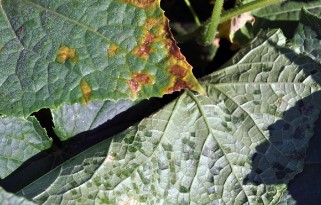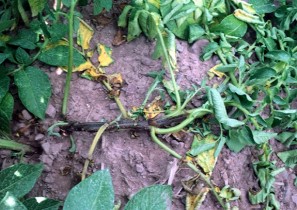Irregularly shaped late blight lesion on a tomato leaf with characteristic white sporulation on the underside of the leaf.
Downy mildew has been confirmed in Dorchester County MD on cucumber, late blight confirmed on tomato transplants, and there have been a number of reports of poor potato seed emergence.
Downy Mildew Confirmed on Cucumber in Maryland
Last year the first report from the mid-Atlantic was on June 21st from the same county in Maryland. This is the furthest northern report beyond those reported in North and South Carolina and Georgia. In North Carolina and Georgia, cucumbers are primarily affected while in South Carolina downy mildew has been reported on cucumber, butternut squash, acorn squash, yellow/summer squash, and cantaloupe.
Fortunately, the weather patterns have restricted the risk area to right along the east coast with the spread remaining local around the source fields. It is never too early to start scouting your cucurbits. Even small seedlings are susceptible. On cucumber look for light yellow (chlorotic) spots that are restricted by the leaf veins. As the disease progresses the spots become brown. On the lower leaf surface opposite the yellow spots, purplish grey sporulation will be seen under conditions of high humidity. Downy mildew can often be confused with the bacterial disease angular leaf spot (see photos below). The symptoms are very similar; the lesions are initially water soaked in appearance before turning brown or straw-colored and are also vein limited. The lesions will often dry and drop out, leaving irregular shaped holes in the leaves. If you do not see downy mildew sporulation in the field, place several symptomatic leaves in a sealed bag overnight and then check for purplish gray sporulation the next day.
Different cucurbit crops are susceptible to different strains of the pathogen which is why we do not see it on all our different types of cucurbits at the same time. Usually, we see it on cucumber and cantaloupe/muskmelon first in the season and on jack-o-lantern pumpkin later in the season.
Remember that the pathogen that causes cucurbit downy mildew does not survive to overwinter unless on living plant tissue so for Pennsylvania growers, the pathogen is typically moving in via long-distance transport from other infected fields sometimes over 100 miles away. Awareness of where potential sources of the pathogen and forecasted weather conditions can help guide in-season management decisions. For the latest information on outbreaks and to receive email or text alerts please visit the Cucurbit Downy Mildew Forecasting website. Updates will also be made to the 1-800-PENN-IPM hotline weekly or more frequently if needed to provide growers with information that can be used to help make timely management decisions. The forecasted risk maps are also based on knowing where there are downy mildew infected fields (sources of the pathogen) so it is important if you suspect downy mildew on your farm to let me know either by email at bkgugino@psu.edu or by phone at 814-865-7328 or contact your local Penn State Extension Office.

Downy mildew lesions on the upper surface of a cucumber leaf and water soaking on the underside early in the morning.
Late Blight Confirmed on Tomato Transplants in PA And NY
Late blight was confirmed by the PA Department of Agriculture on transplants that were supplied from New York State to a smaller garden center in the far northeastern region of PA (Susquehanna County). These plants have since been destroyed but some plants from a previous shipment were sold and may be planted out in some nearby gardens. Plants from this supplier were not shipped to any other garden centers in PA. Late blight was also confirmed on transplants in New York and subsequently destroyed as directed by NYS Department of Agriculture and Markets. According to NYS Ag and Markets and the Cornell Plant Disease Clinic, the late blight strain detected is not one of the known or common strains that we have typically seen over the past several years. Researchers at Cornell are working to further characterize the isolate. Unfortunately, the sample collected from the PA transplants was too degraded to determine the genotype.
Keep in mind that tomato and potato are susceptible at any growth stage. It is characterized by lesions that are irregular in shape and initially water-soaked and pale-green before turning more gray-brown in color. Under humid conditions, the lesions on the underside of the leaves will sporulate giving them a fuzzy white appearance. The lesions will tend to develop on the upper to middle part of the plant as opposed to early blight and Septoria leaf spot (tomato only) that start on the lower leaves and progress up the plant.
Although not reported in PA this season, there have been numerous reports of Phyophthora nicotianae on both potato and tomato in North Carolina due to the excessive wet weather. The symptoms can look very similar to those of late blight. However, this pathogen does not produce a lot of spores so fuzzy white sporulation will not be observed on the leaves. Symptoms tend to develop on the lower part of the plant as a result of soil splashing.
If you suspect late blight on your farm, please contact your local Penn State Extension Office or let Beth Gugino know via email at bkgugino@psu.edu or by phone at 814-865-7328. We are interested in collecting samples so we can better understand how the pathogen population is changing both within and across growing seasons. Also for the information regarding where the latest confirmed outbreaks have been reported and to receive email or text alerts about when late blight has been confirmed with a personally defined radius from your location visit
USA Blight website.
Poor Emergence Observed in Some PA Potato Fields
Thanks to the excessively wet conditions, there have been a number of reports of poor potato seed emergence over the past couple of weeks. Upon inspection, growers have either found decaying seed pieces or symptoms of blackleg on emerging plants. Blackleg has typically been caused by the bacterial pathogen Pectobacterium atrosepticum but in some cases more recently it has been caused by a species of Dickeya. Both bacterial pathogens are seed-borne so it is common to see symptoms associated with specific seed lots and cultivars. Blackleg caused by Dickeya is described as being more aggressive and favored by warmer temperatures. So far this season, Dickeya dianthicola has been confirmed in New Jersey on ‘Norwis’ potato that originated from Prince Edward Island and Pectobacterium spp. confirmed on ‘Dark Red Norland’ originating from P.E.I and ‘Atlantic’ from Maine. The pathogens associated with the samples submitted from PA potato fields are still in the process of being identified. If you suspect black leg in your field, please contact me by email at bkgugino@psu.edu or by phone at 814-865-7328 and/or submit a sample to the
Penn State Plant Disease Clinic. We are interested in collecting samples for confirmation of blackleg as well as determining whether it is caused by Pectobacterium or Dickeya.

Potato stem with characteristic blackleg symptoms.